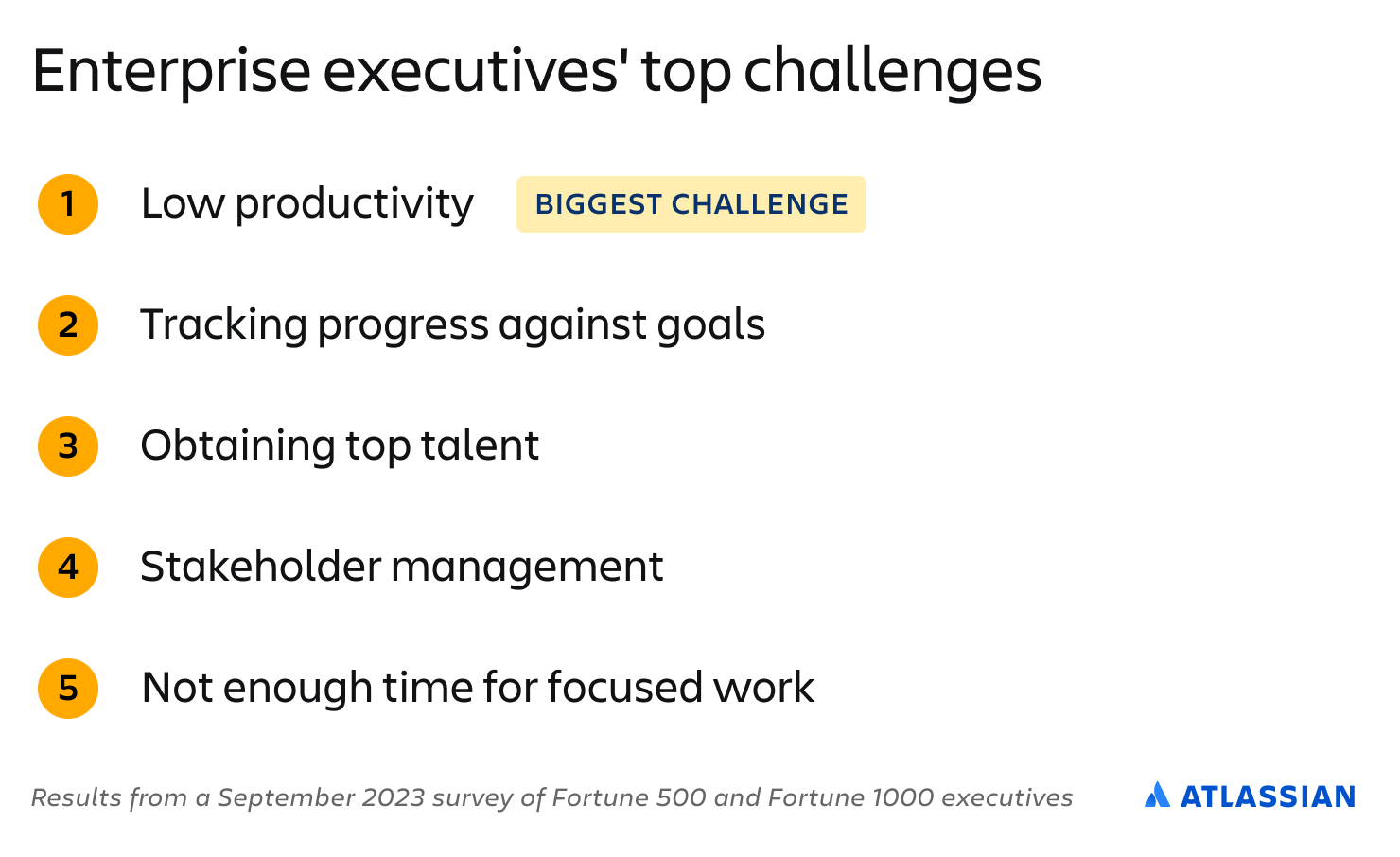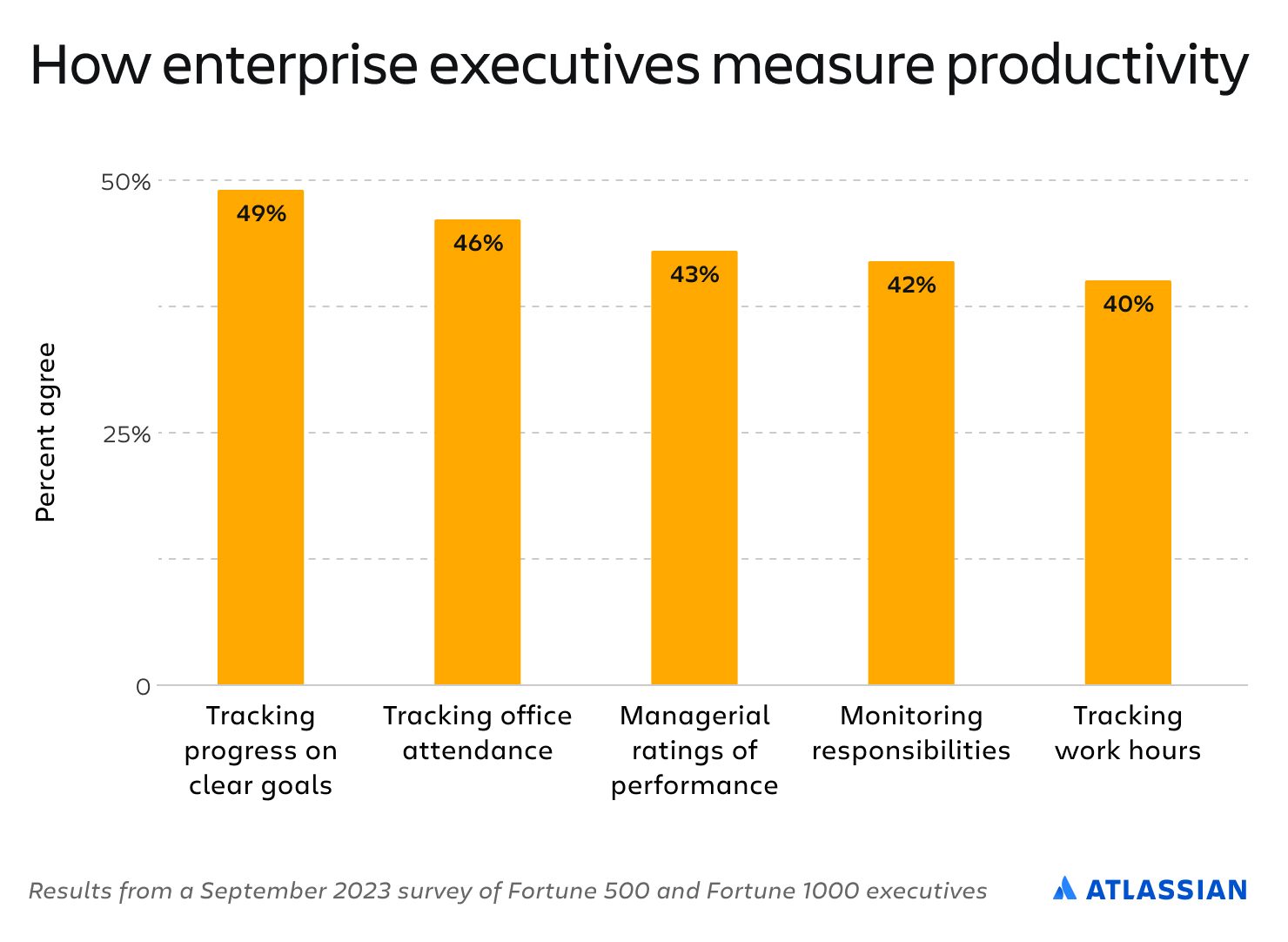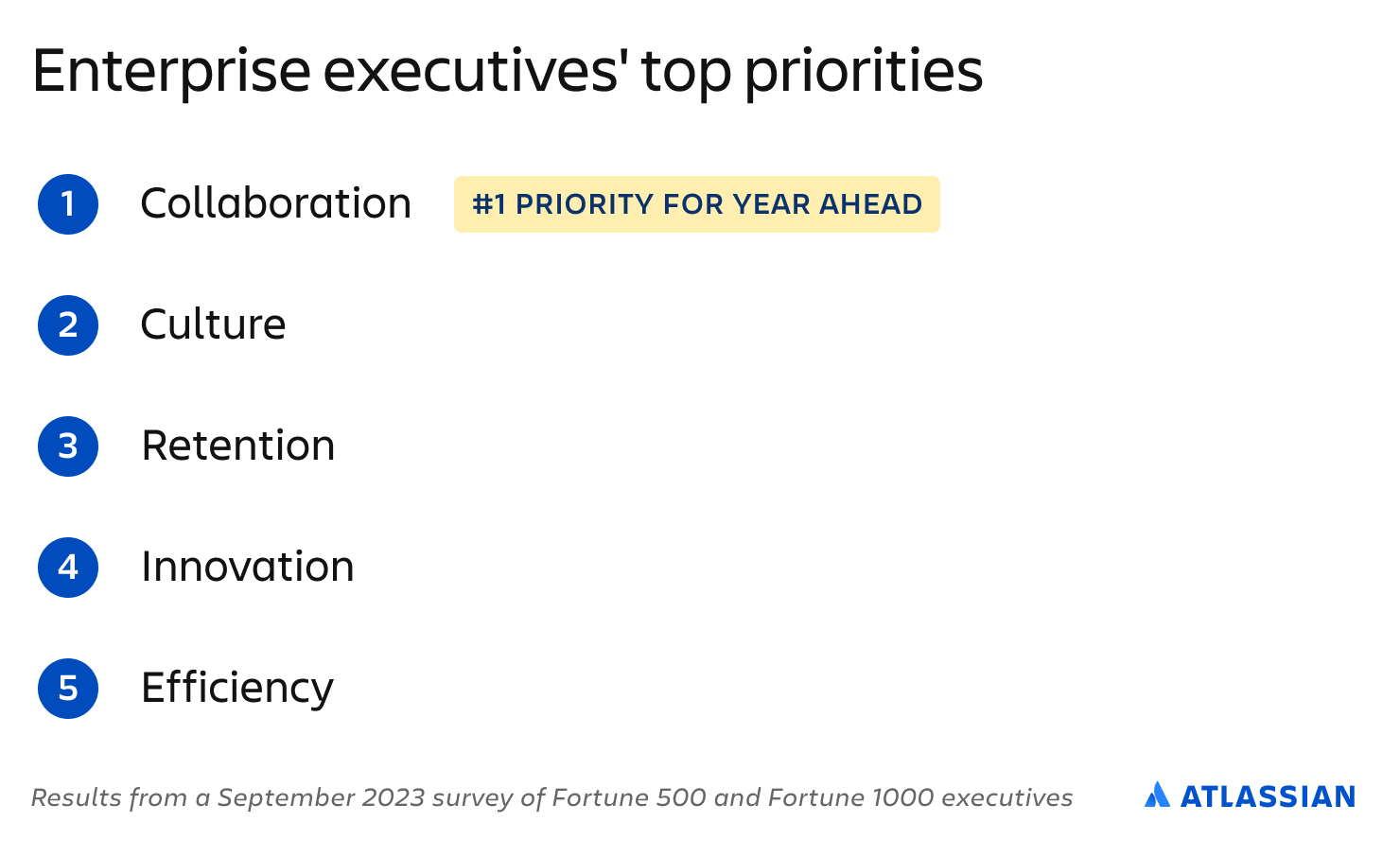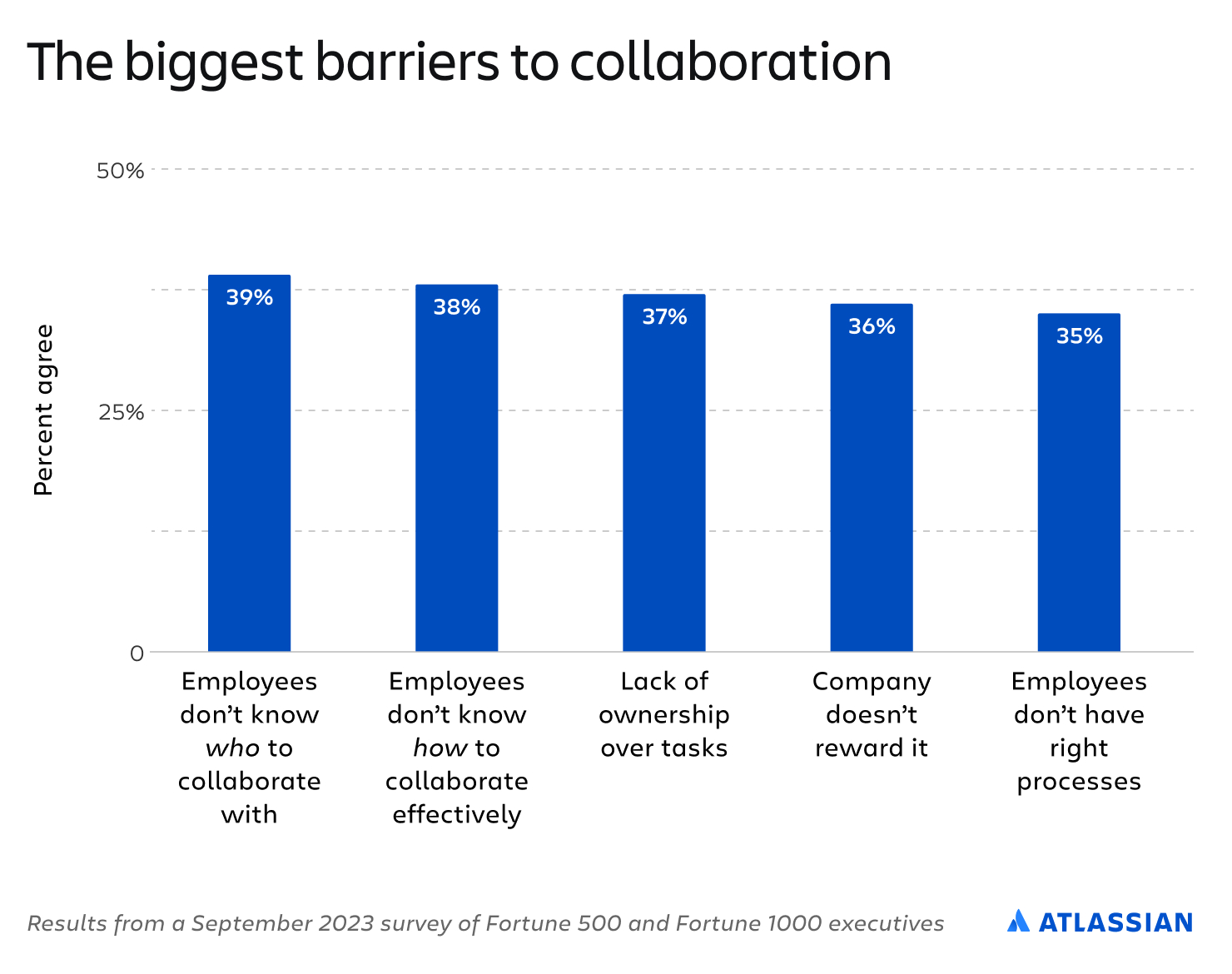What return-to-office debates often miss is that how teams work has fundamentally changed, regardless of where individual team members sit. Whether a large organization is remote, hybrid, or fully in-office, most of their employees work in a distributed way.
Distributed work: A term that describes how work gets done, not where. Distributed work is done online (vs shoulder to shoulder). Most knowledge workers use the internet to collaborate across a distributed network, most of the time, regardless of where they’re working from.
Even if you’re in an office, you likely spend your days bouncing between Zoom calls with teammates based in different locations, sending emails to external partners from around the world, and firing off Slack messages to colleagues sitting on another floor. In other words, you’re largely collaborating online and across locations. You’re doing distributed work.
Our latest research confirms this. At Atlassian, we take a scientific approach to designing and validating best practices for distributed work. To inform our efforts, we wanted to assess just how common distributed work is and to better understand what enterprise executives see as their top challenges. With these goals in mind, we surveyed one hundred Fortune 500 executives and another hundred Fortune 1000 executives in September 2023.
The results were clear: executives said that the majority of their teams do not sit shoulder-to-shoulder (even if individual members frequently go into offices), work will only become increasingly distributed, and how their teams collaborate is more of a pressing problem than where they work.

Enterprise executives also told us that their top focus areas for the year ahead are low productivity, tracking progress against goals, and effective collaboration.
Challenge: Low productivity
Executives rated low productivity as their top organizational challenge.

Our research also indicates that they aren’t quite sure how to effectively measure productivity, or are not confident in the metrics they’ve chosen. Despite the fact that almost half of executives assess productivity by tracking office attendance, only one in three think that their return-to-office policy has had any impact on performance.

Try this solution: Allow employees to timebox around top priorities
When employees design their workdays around their most important work – not around reacting to messages and attending meetings – they become more productive. A recent internal experiment we ran showed that when employees intentionally restructured their calendars to ensure they had enough time to work on their top priorities, they made faster progress, reported higher goal clarity, and wasted less time in unnecessary meetings.
To boost productivity even more, have employees also track their progress at the end of each day. In our experiment, participants who made it a point to both intentionally design their calendars and track their progress every day reported 16% more goal clarity, a 30% larger boost in workload sustainability, and 31% more progress on top priorities than in a typical week.
Challenge: Tracking progress against goals
Tracking progress against goals may be executives’ second biggest challenge due the fact that team-level goals are often not clear or aligned. Executives cite that goals can be too ambitious (45%), contradict each other (41%), and that resources required to meet them are often not available (40%).
Team goals also tend to be narrowly shared across the organization.
Only 13% of executives say that teams have complete visibility into each other’s priorities and the progress they’re making toward those milestones.
That said, our research revealed that leaders whose organizations are highly distributed, meaning teams are spread across more locations and time zones, report 18% higher goal clarity. They’re also 2.7x more likely to say that their teams have visibility into each other’s goals and processes. These findings align with our internal data, which shows that more distributed teams (meaning members are spread across three or more time zones) establish more effective ways of working out of necessity.
Try this solution: Focus on outcomes, not tasks
Aim to measure and reward high-quality work that’s produced over time rather than office attendance or short-term “busywork” tasks. At Atlassian, we set clear goals that are aligned and visible across the whole organization by using Objectives and Key Results (OKRs), a goal-setting system. Every OKR ladders up to a single, big company milestone and we guide teams to write OKRs consistently and with measurable actions.
Teams share weekly progress updates and monthly scoring on their OKRs in Atlas, our goal-setting and teamwork directory tool. These summaries include details on key decisions that were made, what’s on track, and what’s off track. All of this is accessible to every Atlassian, creating the kind of organizational alignment that’s critical to achieving big, shared goals.
Challenge: Effective collaboration
Leaders rated collaboration as their top priority in the year ahead, and reported that employees struggle most with how to collaborate and with whom.

Collaboration was ranked higher than culture, retention, and efficiency, indicating that leaders and employees may be finding it challenging to work together effectively in a more distributed, post-pandemic environment.

Try this solution: Make intentional connection a priority
Enable employees to build networks of collaborators by making time for in-person connections on a regular basis. To be clear, that doesn’t mean everyone needs to spend 260 business days a year in an office. In fact, we’ve found that bringing teams together just 3-4 times a year has a greater impact on connection than sporadic office attendance.
The key is to create a structure and expectation that each team gathering (AKA offsite) includes time to both advance important projects and facilitate relationship-building. To support intentional connection, we have a team that applies a hospitality lens to gatherings, guiding managers on what kind of activities and agenda will make for the best experience.
We find that team gatherings increase team connection by 27%, and this boost lasts 4-5 months. These types of events are especially effective for new graduates and new hires: 96% of new graduates told us they felt connected to their team after a team gathering compared to 74% before they attended an in-person offsite.
More distributed work solutions to come
The top challenges enterprise executives face do not magically go away the moment their employees walk into an office. Instead, they require intentional, research-backed improvements to how collaboration and connection happens.
As the largest known organization committed to distributed work, Atlassian is taking an evidence-based approach to determining the most effective ways of working for distributed teams. We’ll continue sharing what we’ve learned – and where we’ve stumbled – so stay tuned for more research and recommendations in the coming months.





 )
) 





































